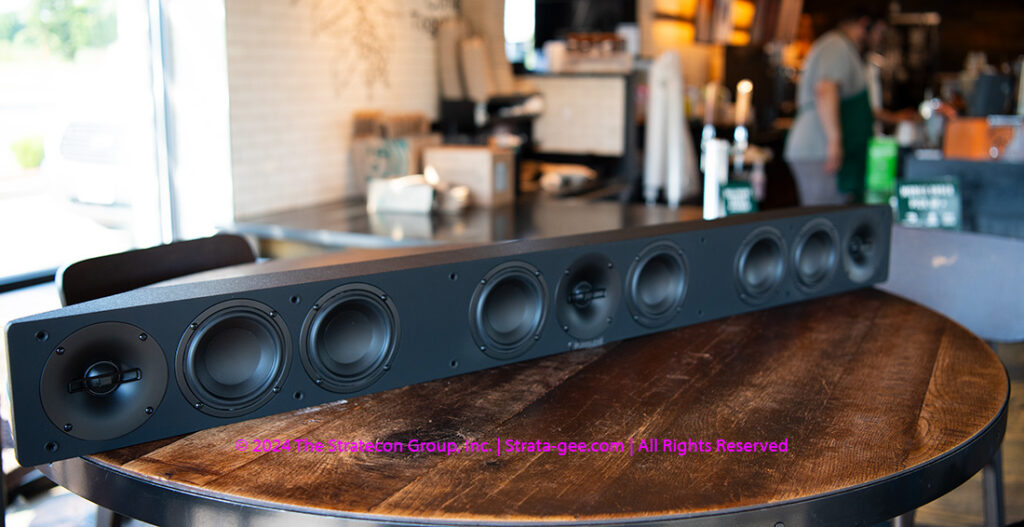
Earlier this summer, executives from Russound visited me to offer me (and Strata-gee readers) a pre-CEDIA Expo sneak peek at some newly redesigned models that are in many ways smarter. I say smarter because these new designs reflect input from integrators (as well as some industry trends) and have launched new sleeker (such as 1U models) and smaller footprint products (such as its popular mini-AVR models). The company is also previewing a new industrial design that I like a lot.
See new models from Russound
Russound executives Charlie Porritt and Colin Clark made the trek to central New Jersey earlier this summer during one of the more impactful heatwaves – with multiple triple-digit days – we’ve experienced this year. In their possession, several new models that would be shown at the 2024 CEDIA Expo. New products always intrigue me – cool new products are about the only thing that can draw me out of my air conditioning on a hot day…and I was glad I did.
We started our meeting with a bit of a review of the market position of the Russound brand. Clark told me that the company surveyed its dealers and asked them what words would they use to describe Russound. They then took all of these words to construct a word cloud – where the size of each word was based on how often it was mentioned. What jumped out as the most prominent were “words like value, reliability, quality, durability, bulletproof, – the way the products last when you install them,” Clark told me. “The word value was the key.”
Dealers Say Russound’s Product Reliability Protects Their Profits
Clark added that one big drain on profitability for integrators is defective products which require multiple truck rolls for first the installation…then the uninstall…then the reinstall of a replacement model. Not all manufacturers reimburse for these extra truck rolls.
And that’s why customers support our brand. They can go sell the product and install it once. They don’t have to go back to service the system again. That’s a core element of our business, and that’s something we always want to continue.
Colin Clark, Russound
New Amplifiers with New and Attractive Industrial Design
The company has spent the last 12-18 months redesigning a new industrial design (some manufacturers call it a cosmetic design) and the executives set up a new amplifier to show me the new look. The amp they showed me is the D1290, a twelve-channel, 90 watts per channel (at 4Ω) workhouse amp.
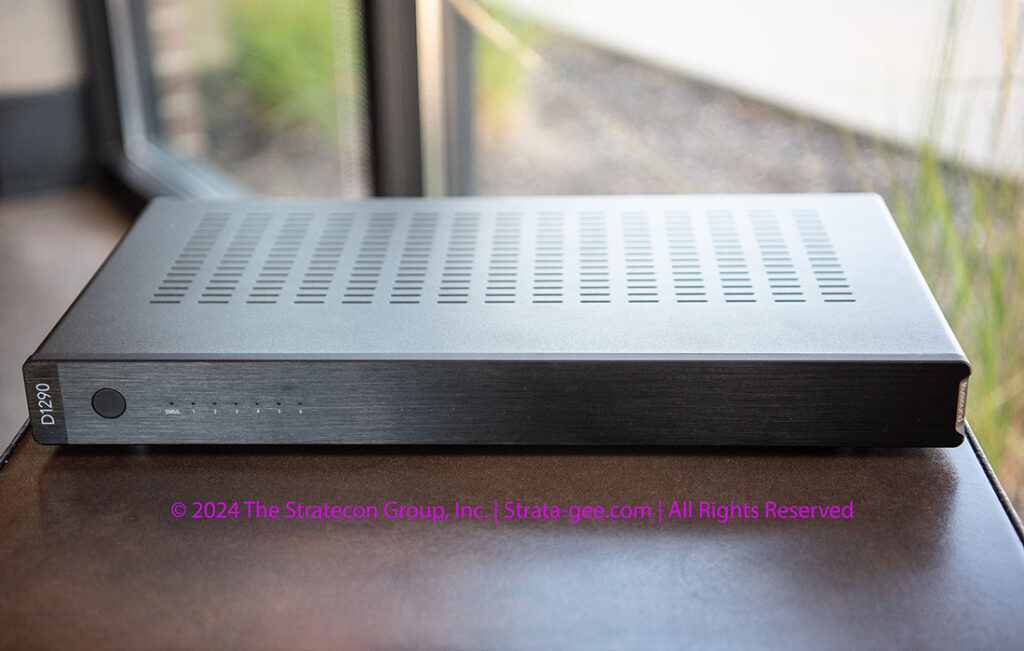
The new industrial design struck me immediately – a sleek, solid look. A bit of a surprise to be able to stuff 12-channels of 90 beefy watts of power in a slim 1U chassis that looks clean…but solid.
New Design is Across Models for Consistent Brand Presence
One nice touch to the new design is that they put the Russound brand on a radius cut at the end of the front panel. This makes it prominent but not obtrusive…and visible from both the front and the side of the unit. Neat! Picking it up it feels really solid…not heavy, but solid.
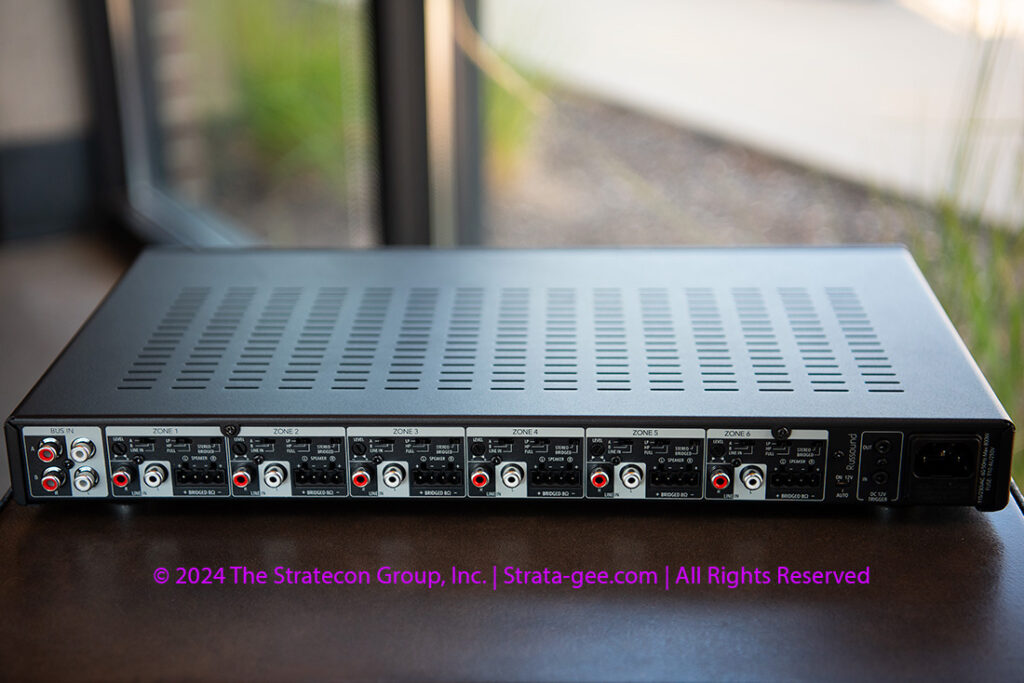
This new industrial design will be replicated across product categories for a unified look. Clark says LEDs will line up, power buttons line up, all in pursuit of a consistent brand presence.
The D1290 is a fully featured Class D amplifier with low-pass and high-pass filtering, control flexibility (always on, signal sensing, 12v trigger), is rack mountable, and comes with a two-year warranty. It is one of three new models in this series: an 8-channel model, a 12-channel model, and a 16-channel model.
AVA 3.1 Mini AVR
In my report from the 2023 CEDIA Expo, I noted that several companies introduced a new product concept…the mini AVR. A mini AVR is a small form factor device that replicates most, if not all, of the functionality of the more traditional audio/video receiver. While all of the designs were cool, Russound had the smallest version which is perfect for easy installation. You can easily tuck it behind the smallest, thinnest flat-panel TV.
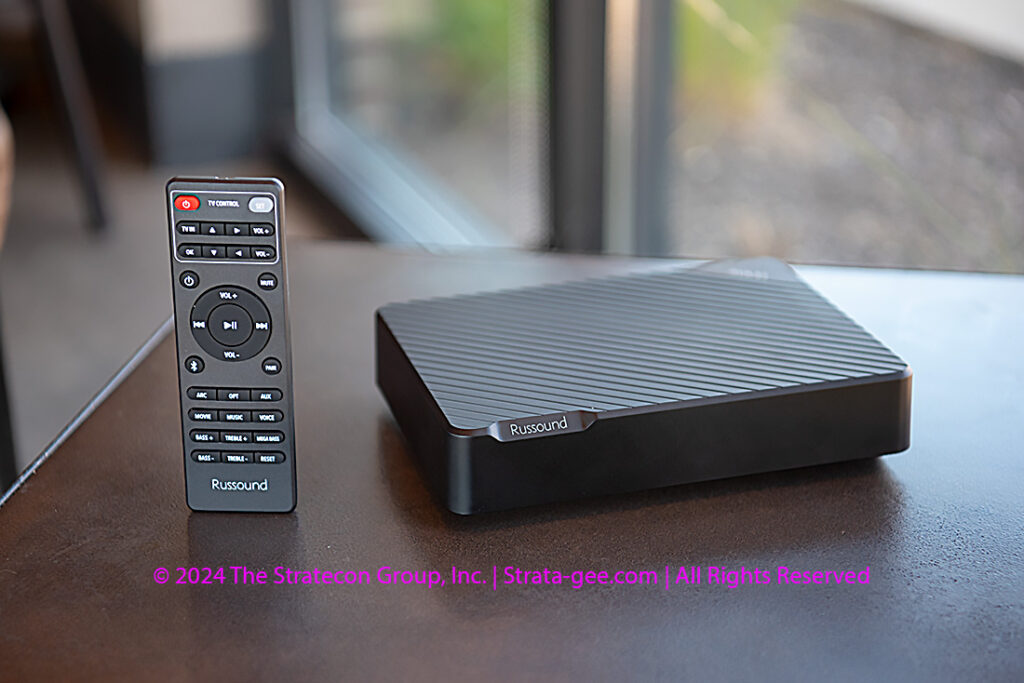
Integrators tell me that this is an increasingly popular option, with some saying they install multiples of them in homes in multiple rooms in a typical installation. Now, in fact, many of them are not truly A/V receivers, which as you likely know is a device that combines an amplifier, preamplifier, and tuner in one chassis. Many of these mini versions don’t contain, for example, a tuner section.
No Analog Tuner…BUT Bluetooth Connectivity to Access Your Favorite Streaming Service
However, Russound’s version contains Bluetooth built-in which enables streaming from your favorite handheld device so you can access your favorite digital music streaming service. Kind of like a modern, or digital-era, version of a tuner, so to speak.
But what Clark told me really distinguishes the AVA 3.1 from the other mini AVRs on the market is it includes HDMI connectivity. He believes Russound is “the first and maybe the only” mini AVR to include HDMI – an HDMI port, by the way, with ARC (audio return channel) and CEC control – which greatly enhances the simplicity of TV and audio control for end users.
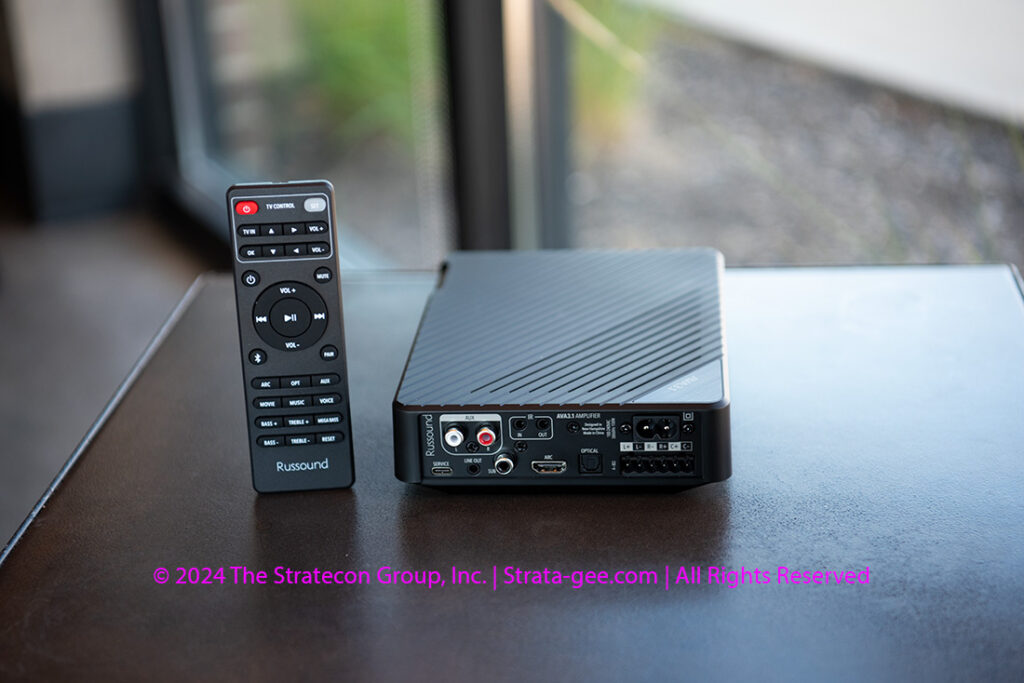
Simple to Connect, Even Simpler to Operate
Simply connect to your TV via the HDMI w/ARC (and CEC control) and add up three speakers and you are in business. The user gains tremendously enhanced TV sound and simplified control since their regular TV or Cable/Satellite remote will now control the enhanced audio. What’s not to love?
The AVA 3.1 supports up to 4 total inputs (HDMI, Digital Optical, Line-Level Stereo, Bluetooth) for even more flexibility. It offers up to 50 watts per channel (at 4Ω), which is plenty of power for the vast majority of use cases, 3.1 connectivity (with a subwoofer output), and much more.
The AVA 3.1 has already won multiple industry awards and when you take a closer look at it, it’s easy to see why.
Cinema Bar 3.0 Premium Performance 3-Channel Passive Soundbar
There was some kind of weird bio-rhythms thing going on as we neared the end of our meeting. I met with the Russound execs in a local coffee bar and the staff there basically ignored us as we discussed the electronics the company had brought in to show me. But when they brought in the Cinema Bar 3.0 Soundbar, the coffee bar workers suddenly got really interested. Over-caffeinated? Maybe, or just possibly this is an eye-catching alternative soundbar product that will be attractive to a wider audience of potential purchasers.
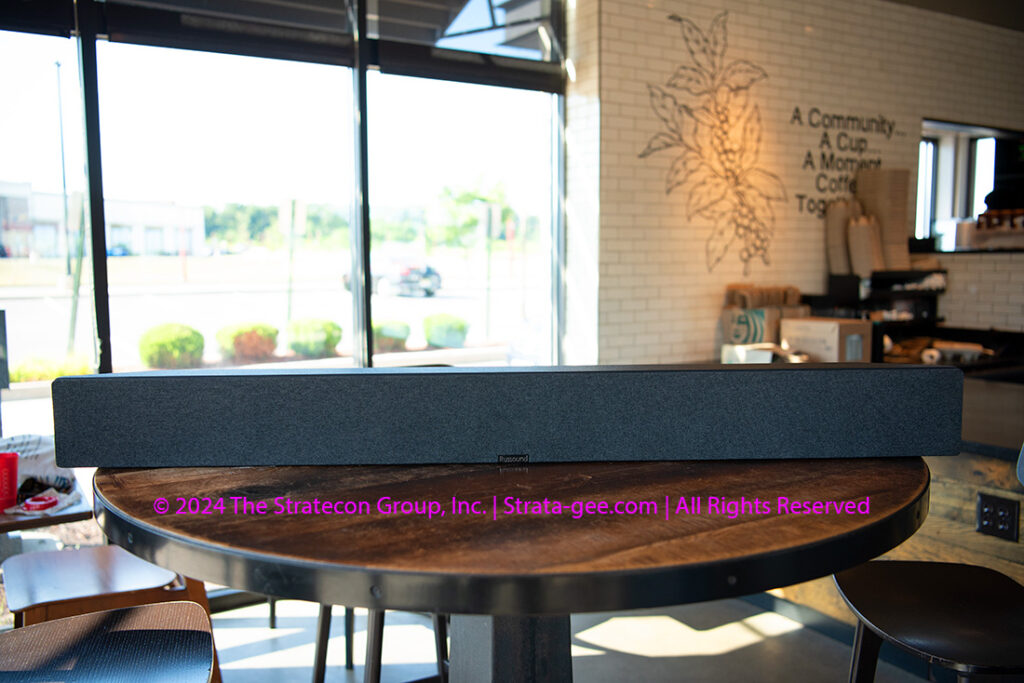
This is the company’s first soundbar product, although they previously showed a couple of different configurations. This latest version is a passive soundbar which of course means that separate amplification will be needed. This fact was my first question…why a passive soundbar when so many other brands are offering powered soundbars?
Passive Soundbars are More Popular Than You May Realize
Russound CEO Charlie Porritt told me that market research shows that the category is really quite popular.
I don’t know about right now, but I can tell you, five months ago, Crutchfield had 47 different passive sound bars for sale.
Charlie Porritt, Russound CEO
I checked more recently and find that Crutchfield has trimmed their offerings a bit, but still offers a robust assortment of 23 different models of passive soundbars for sale. So that backs up what the Russound CEO was saying.
Powered Soundbars Rule Consumer Markets; Passive Soundbars Rule Integration Channel
Both executives admitted that in the greater consumer market, powered subwoofers are more popular. But in the custom integration channel, passive subwoofers give integrators more flexibility to pair the speaker with the best brand and size of amplifier to meet the needs of that particular client in that particular installation.
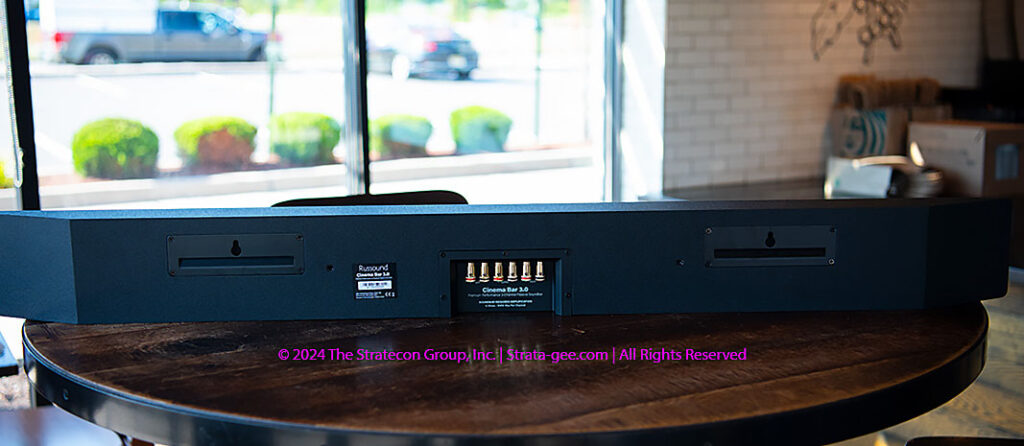
Cinema 3.0 offers three sets of speakers in divided chambers. Thanks to the use of passive radiators, bass extends down to 80Hz, the company claims – incredibly deep without any subwoofer needed. So in each chamber, there is a custom-designed 4″ long-throw polypropylene woofer, a 4″ polypropylene passive radiator for bass enhancement, and a 1″ custom-designed soft-dome tweeter with proprietary waveguide and phase plug. Power handling is rated at 100 watts RMS per channel.
A Clever Mounting Bracket for Easier, More Professional Installations
The company has thoughtfully designed a simple installation system with a wall-mounted wedge-like bracket that slips neatly into slots on the back of the Cinema 3.0. The mounting channels are designed to give the installer flexibility, as the unit can be slid from side to side to avoid studs or perfectly line up with the position of the TV. They also make this a quicker, easier install of the soundbar that could be easily handled by one install tech.
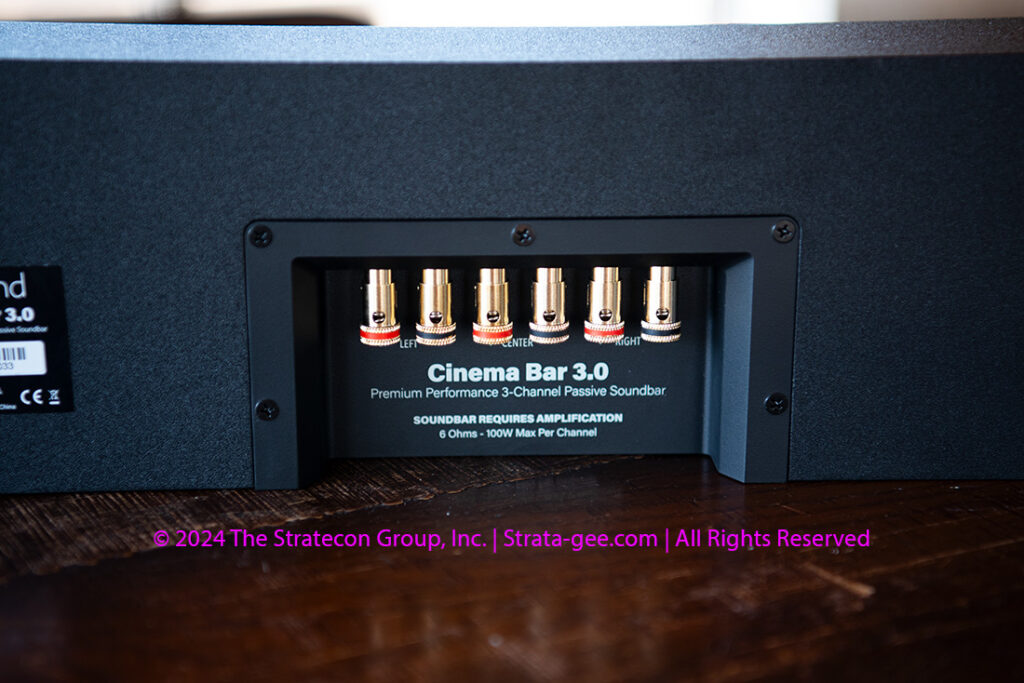
Constructed of solid, reinforced MDF (medium-density fiberboard) like other Russound products, the Cinema 3.0 has a clean, professional look. Russound says it is priced at $499 MSRP.
See Russound at CEDIA Expo Booth #2524
The company says they will have all of these as well as several other new products for integrators to see at CEDIA Expo. Be sure to stop by and see them at Booth #2524 in the Colorado Convention Center in Denver from September 5-7, 2024.
Learn more about Russound at www.russound.com.





Leave a Reply